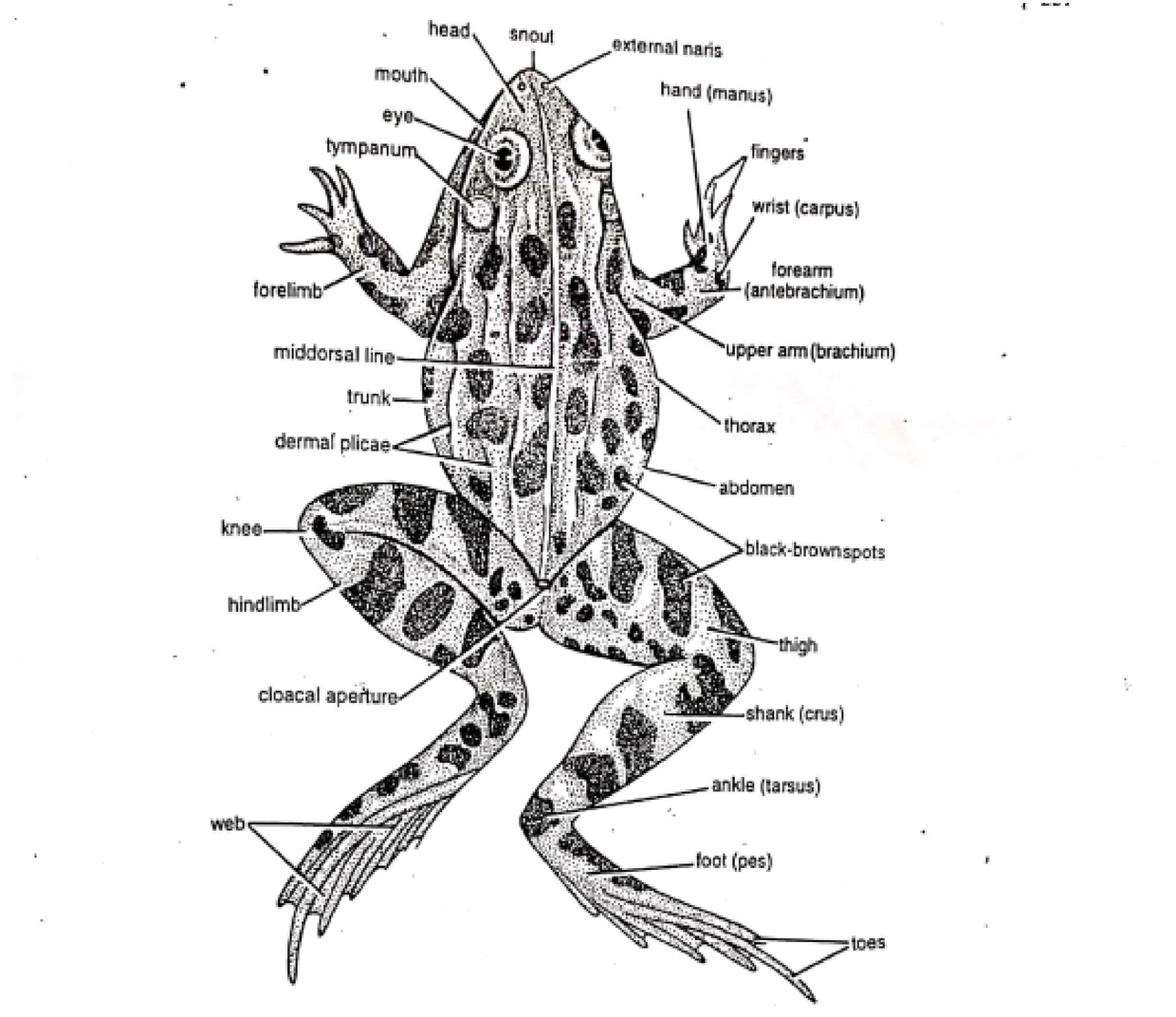In this article, We will learn the external morphology of frog (Hoplobatrachus tigerinus or Rana tigrina) which is commonly known as the Indian Bull Frog. Rana tigrina is the previous scientific name of the Indian Bull Frog but it is recently updated to the Hoplobatrachus tigerinus.
Systematic Position of Indian Bull Frog
| Kingdom: | Animalia |
| Phylum: | Chordata |
| Class: | Amphibia |
| Order: | Anura |
| Family: | Dicroglossidae |
| Genus: | Hoplobatrachus |
| Species: |
Hoplobatrachus tigerinus
|
Diagram of Hoplobatrachus tigerinus

External Morphology of Frog
1. Shape
- As the frog spends most of its time in the water, its body is streamlined or spindle-shaped in order to swim more efficiently.
- Its body is pointed anteriorly and rounded posteriorly.
- The body is slightly dorso-ventrally flattened.
2. Size
- Hoplobatrachus tigerinus varies from 12-18 cm in length.
- It also varies from 5-8 cm in width.
3. Color
- The color of the skin is green dorsally and pale-yellow ventrally.
- There are numerous black or brown spots on the dorsal side of the body.
- The Indian Bull Frog is called Hoplobatrachus tigerinus due to its mottled coloration like that of the tiger.
- A light yellow mid-dorsal line runs from the tip of the snout to the cloacal opening on the back.
- There are three layers of pigment cells in the skin of the frog. These pigments are melanophores, guanophores, and lipophores.
4. Skin
- The skin of frog is thin, moist, slimy, smooth, slippery and fitting loosely on the body.
- There are no scales or any hard exoskeleton on the skin.
- Dermal plicae are present on the skin at the dorsal side of the body.
- The frog uses its skin for respiration.
5. Division of Body
- The body of frog is divided into head, trunk and limbs.
- The neck and tail are absent.
6. Head
- It is the anterior part of the body.
- It is roughly triangular in shape.
- It is dorso-ventrally flattened.
- It is pointed anteriorly.
- The head bears various organs and they are snout, mouth, external nostrils, eyes and tympanum.
- The frog doesn’t bear parotid glands like the toad.
a) Snout
-
-
- The snout is present at the anterior end of the head.
- It is pointed anteriorly.
- The snout bears external nostrils.
-
b) Mouth
-
-
- It is a wide transverse aperture and the largest aperture of the body.
- It is present at the terminal end of the head, just beneath the snout.
- The mouth is extended from one side of the snout to the other side of the snout.
- It is bounded by upper and lower jaws.
- Lips cover the jaws and the lips are immovable.
-
c) External Nostrils
-
-
- Two small openings are present above the mouth, at the tip of the snout.
- These openings or external nostrils are the respiratory organs of frogs.
- The air enters the body through these openings.
-
d) Eyes
-
-
- Two large, spherical and protruding eyes are present dorso-laterally on top of the head.
- Eyes are bounded by upper and lower eyelids.
- The upper eyelid is thick and almost immovable.
- The lower eyelid is thin, semi-transparent and movable.
- There is a third eyelid present called the “Nictitating membrane” which covers the eyeball and it protects the eyeball during swimming.
-
e) Tympanum
-
-
- Behind and below each eye, a circular area is present called the tympanum or eardrum.
- Frog lacks external ear and the tympanum works as the external ear.
- It receives sound waves.
-
7. Trunk
- The Head is joined behind the trunk.
- Its back is raised in the middle in a characteristic sacral prominence of hump, especially conspicuous when the frog is squatting.
- At the posterior end of the trunk, there is an aperture called the cloacal aperture by which the frog expels out its faecal matters, urinary wastes and reproductive products.
- The cloacal aperture is present between the two hindlimbs.
8. Limbs
- Two pairs of limbs are present on the trunk and they are forelimbs and hindlimbs.
a) Forelimb
-
-
- A pair of forelimbs arises from the anterior part of the trunk.
- These are shorter and weaker than the hindlimbs.
- Each forelimb consists of brachium (upper arm), antebrachium (lower arm), carpus (wrist) and manus (hand).
- Each hand bears 4 digits.
- Digits are not webbed.
- Thumb or pollex is vestigial.
-
b) Hindlimb
-
-
- A pair of hindlimbs arises from the posterior part of the trunk.
- These are larger and stronger than the forelimbs.
- Each hindlimb consists of femur (thigh), crus (shank), tarsus (ankle) and pes (foot).
- Each foot bears 5 digits.
- Digits are webbed and modified for swimming.
- In addition, there is rudimentary sixth digit called prehaullex which is enclosed within the skin and is not seen as sixth digit.
-
————-THE END————
Read More:
- Digestive system of Frog with Diagram
- Blood Circulatory System of Frog | Diagram
- Urinogenital System of Frog | Diagram
- Nervous System and Sense Organs of Frog | Diagram
- Respiratory System of Frog | Diagram
- Hoplobatrachus tigerinus (Previously Rana tigrina) | Indian Bull Frog
- General Characters of All Classes of Vertebrates.
Reference:

Md Ekarm Hossain Bhuiyan is a dedicated zoology graduate with a profound passion for the study of animal life. He completed his primary and secondary education at Ispahani Public School and College, renowned for its commitment to academic excellence. He then pursued his secondary education at Government Science College. After that he achieved graduation at Department of Zoology, Jagannath University. His educational background and enthusiasm for zoology position him to make meaningful contributions to the field of biological sciences in Bangladesh.